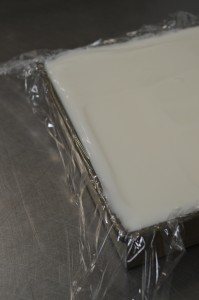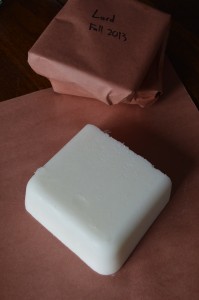 If you had told me five years ago that one day I would make soap I would have scoffed with self-righteous indignation. Being a very serious chef and a bit of a dink I eschewed the “arts and crafts” that took precious space away from food at the farmers’ market. I don’t feel that way anymore: I appreciate the pottery and the quilts and the pysanka, and even the beeswax candles.
If you had told me five years ago that one day I would make soap I would have scoffed with self-righteous indignation. Being a very serious chef and a bit of a dink I eschewed the “arts and crafts” that took precious space away from food at the farmers’ market. I don’t feel that way anymore: I appreciate the pottery and the quilts and the pysanka, and even the beeswax candles.
For the past few years I have been rendering lard from sides of pork. Now, I think I eat more lard than most: I use it in pie dough, I make spreads like Grammelschmalz and Schmalzfleisch, and use it as an everyday cooking fat. Even so, I can’t … Continue reading.
 I’ve rendered animal fat many times, but I recently learned that I was doing it wrong. Or rather, not in the most effective manner.
I’ve rendered animal fat many times, but I recently learned that I was doing it wrong. Or rather, not in the most effective manner.
Rendering is the process of turning raw, fatty tissue from animals into pure fat. We render pieces of raw pork fat to get lard, and raw beef fat to get tallow. I used to quickly cut up, say, pork leaf lard, or beef suet, or duck breasts, then throw them in a pot over low heat and leave them for several hours. This works, but I was always surprised by the low yield.
My exploration of an improved rendering method began last summer, in Austria, while eating at a Heuriger. I was served light rye … Continue reading.
The personal website of Edmonton chef Allan Suddaby
 If you had told me five years ago that one day I would make soap I would have scoffed with self-righteous indignation. Being a very serious chef and a bit of a dink I eschewed the “arts and crafts” that took precious space away from food at the farmers’ market. I don’t feel that way anymore: I appreciate the pottery and the quilts and the pysanka, and even the beeswax candles.
If you had told me five years ago that one day I would make soap I would have scoffed with self-righteous indignation. Being a very serious chef and a bit of a dink I eschewed the “arts and crafts” that took precious space away from food at the farmers’ market. I don’t feel that way anymore: I appreciate the pottery and the quilts and the pysanka, and even the beeswax candles.